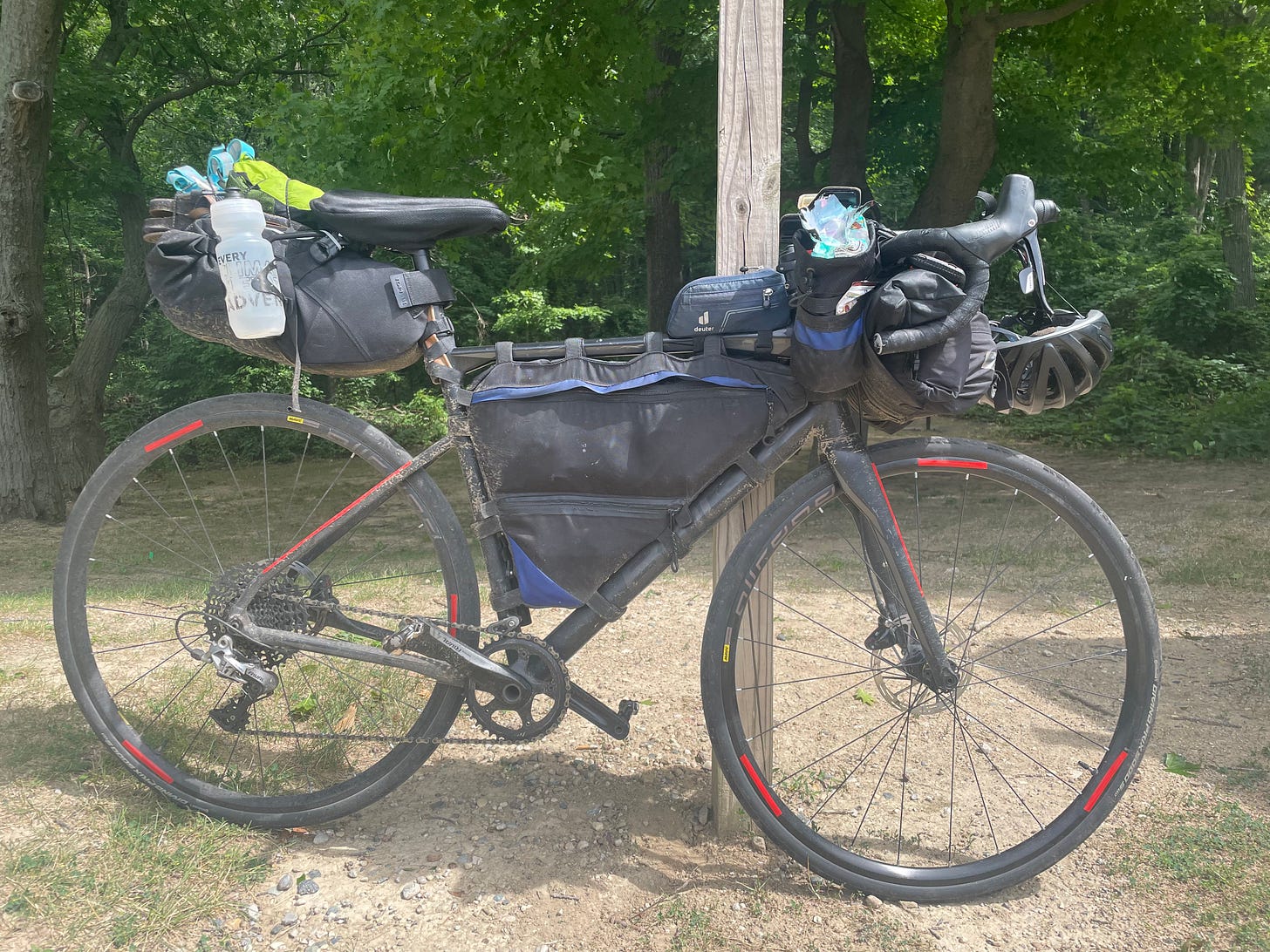Especially in the depths of the offseason, the majority of my weekly high intensity work comes from weightlifting, and specifically the heavy lifts I discussed last week. However, we do want this to translate to bicycle performance, so next on the priority list (and growing in importance as the outdoor season dawns) are high-intensity workouts on the bike. As a reminder, here’s where we’ve been and where we’re going over the next couple weeks.
Part 4 – Bike Intensity
Oh, and make sure you’re subscribed so you don’t miss any of it!
Forever Trying to Push. (Is That Not what FTP Stands For?)
Storytime! In 2022, I was just starting to get deep into the world of bikepacking and ultra distance. Before then, I’d worked up to being vaguely comfortable with 100 mile rides, but that really felt like pushing myself. I’d gotten there just from riding my bike, without any real structured training. I was also focused on bikepacking more than any sort of go-fast discipline. So my thought process was: I’ll just try to hold the pace I’ve been at, and keep trying to stretch further and further.

And it kind of worked! 2022 was the inaugural running of the Mishigami Challenge, and I managed six days back-to-back of 150-200 miles each. The most important thing you can do to improve as a cyclist is indeed to ride your bike more (and enjoy doing it).
All that said, I had zero top end. I could hold 24-25kph (~15mph) almost literally all day, but go up to even 27, 28 kph (~17mph)? I’d struggle.
It was in late 2022 that I first dug into the idea of doing high intensity intervals for the express purpose of improving endurance. It felt so counterintuitive to me at first. I grew up playing soccer – in that context, it made sense to me to train quickness and sprint speed alongside endurance. A soccer game is a long succession of quick, sharp efforts intermixed with brief periods of walking or light jogging.
But as I learned more about training bike intensity (and weightlifting for cycling – that was also new to me), the more it made sense.
I think about it this way. If all you train is long distance, you will progressively get better at riding further, but the ceiling on your speed won’t move. If all you train is an all-out effort, you’ll become a great sprinter – for about 200 meters. It’s a spectrum, and our job is to find the balance.
When on a bikepacking trip or a randonneuring ride, you’re specifically trying not to spike a lot of high-intensity efforts over the course of the day. But if you’re able to go just a little bit faster for the same effort you used to, you’ll go a lot further when that’s multiplied over 10 hours or more. This strikes me as so utterly obvious now, but it really can seem counterintuitive until you’re exposed to the idea. Doing just a little bit high intensity work on a regular basis can massively expand your capabilities as a long-distance cyclist.
Don’t Be a High Intensity Icarus
There’s a lot of research showing that your body reacts differently to different thresholds of physical stress. Going back to the Base Endurance newsletter a couple weeks ago, this is why these rides need to hold so strictly to “endurance zone” work. Your body can build endurance without feeling like it’s being put into a fight-or-flight situation.
Heavy weightlifting and high-intensity bike work intentionally put your body into exactly that situation in order to make it adapt and grow stronger. But every time you put yourself over that threshold, you multiply your body’s recovery needs. This is why effective training limits the number of times per week that you perform high-intensity exercise, and therefore why in the offseason high-intensity cycling is somewhat deprioritized. You aren’t trying to get your legs keyed up for a race in a week or even a month from now. You’re trying to build a strong foundation that you capitalize on later.
Still, a little bit of high-intensity riding has its place, particularly after you’ve moved past the “I’m horrifically sore” phase of weightlifting. Deep in the offseason, I’ll add a high intensity ride every couple of weeks, usually in place of a 3rd endurance ride and often in conjunction with a slightly shorter workout on one of my gym days that week. Your body will tell you when it’s tired. If your legs don’t feel fresh, a low-intensity endurance workout is probably a better way to push yourself. More high intensity will only burn you out and exponentially raise your recovery needs before you can do more training.
Calibrating “High-Intensity”
I don’t have a power meter on my bike. Most of the time, I don’t particularly want one. I spend enough time looking down at the speed, heart rate, and navigation data on my Wahoo already. I don’t need another metric distracting me from the scenery on a beautiful ride.
All that said, on an indoor trainer (or otherwise riding alone), some sort of power data is invaluable. To get the most out of high-intensity rides, they really have to be that: intense. They should be pushing you up near your limit. Yes, there are different kinds of workouts that will do more to address top-end sprint speed, or to build a sustained ten minute effort, but that is almost (almost!) secondary to just going hard enough to make yourself wonder if you’re going to get through the full workout. During the season, a fast group ride can push me to that place. On my own and indoors, power data helps me know that I’m reaching that threshold.
If this is completely new to you, the place to start is with an FTP, or Functional Threshold Power, test. This will give you a number, in watts, that is theoretically the maximum power you’re able to sustain for a full hour (as in, completely emptying the tank in one hour), and it’s the number upon which interval targets are calibrated. FTP tests aren’t a workout worth doing constantly, but checking in on your FTP every few months will help you calibrate your training.
A brief note on equipment: My indoor trainer is not fancy. It’s wheel-on, meaning that the resistance is affected by things like the air pressure in my tires, how tightly I’ve screwed the resistance drum onto the wheel, and how warm the mechanism in the trainer is. I regularly have to recalibrate it. Still, it give a more-or-less internally consistent gauge of what power I’m putting out. Use what you’ve got. If you want to upgrade, great! But it isn’t essential to training cycling intensity.
Regardless of what you use, you generally want to look for workouts that have intervals at or above your FTP. This still covers a range of workouts, from repeated 30 second near-sprint efforts to several 5-10 minute blocks that will push you to sustain a relatively high effort. There are some very deep rabbit holes you can go down about how to optimize your sessions and which workouts to choose, but to keep things simple, mixing these up a bit and making sure they are really pushing you will yield results.
There are lots of different apps that will connect to trainers and give you structured workouts. For the sake of simplicity I use the phone app from the company that makes my trainer; you might have structured workout options built into your Garmin or Wahoo as well. You’ll find similar workouts regardless of where you get them. Here are a few of my favorites:
“Tabata” intervals – Usually a few sets of 5-10 efforts that are 20-30 seconds each with 15-30 seconds at recovery pace between each effort and a few minutes at recovery pace between each set; power targets for each effort are not far off from sprinting.
High intensity intervals – Similar to the above, but sets are often 3-6 efforts per set, usually 1-2 minutes per effort with a similar amount of rest between each effort; power targets per effort are similarly quite a bit over FTP, often in what’s called the “anaerobic zone.”
Power blocks – These can be anywhere from 3 to 20 minutes per each effort and will vary in power targets accordingly but are generally at or just above FTP. Most workouts will be in the 45-90 minute range, fitting as many efforts as possible into that time with a commensurate amount of time at endurance pace between each effort.
My Offseason Bike Intensity Plan
FTP Test at the first session; best performed when reasonably rested for accuracy
Re-test every 2 months
1 high intensity session every 2 weeks through the winter
1 high intensity session every week in early spring





